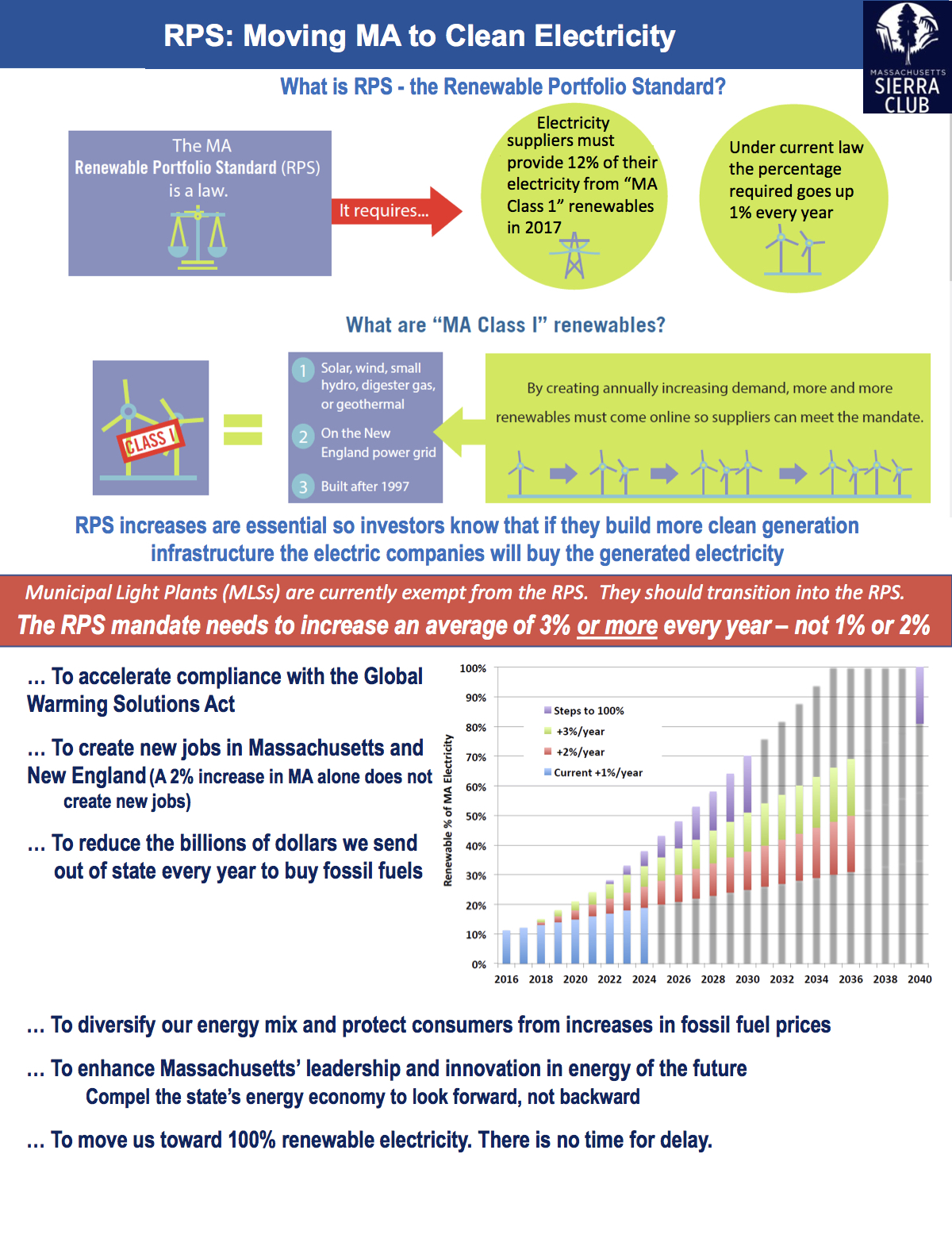Mountains and Climate Change: From Understanding to Action by Paul Dale (Part 2)
/RPS: Moving Massachusetts To Clean Energy
by Paul Dale
This is the second article in a series, “Climate Change: from Understanding to Action” that explores energy and climate change initiatives in Massachusetts and gives specific ways that you can help. (The first article was, “10 Things You Can Do About Climate Change”.)
In a renewable energy economy we will not burn fossil fuels; instead we will use clean electricity for everything: cars, trucks and buses, mass transit, and heating and cooling for buildings. So moving electricity generation to renewable energy sources such as wind and solar is essential for meeting clean energy goals and creating local and regional green economy jobs.
Hopefully you saw the call to action on 7/28/17 from AMC’s VP of Conservation, Susan Arnold, to write or call the Governor to strengthen the Regional Greenhouse Gas Initiative (RGGI). RGGI requires increasing reductions in pollution from fossil fuel power plants each year.
Massachusetts and the New England states have a second hugely important legal mechanism that creates a demand for electricity from renewable sources, electricity with no pollution. This is the Renewable Portfolio Standard or RPS. RPS is a key driver of renewable energy demand and development. Sixty percent of U.S. renewable electricity generation, primarily wind and solar, and 57% of capacity since 2000 has come online because of state RPS requirements. The problem is that under current law the RPS mandates are not nearly strong enough to stimulate further investments in renewable electricity generation. Massachusetts state legislation is required.
The RPS requires that electric utilities provide a certain percentage of the electricity they deliver, to be from renewable sources such as wind and solar. This year it is 12%. Currently that percentage goes up only 1% a year. At this rate we won’t get to 100% renewable electricity until 2105. Several states are already above 30% today. The RPS in NY and CA will reach 50% renewable electricity by 2030; at our current rate in 2030 we will be only half that at 25%.
The primary benefit of the RPS is it provides a long term financial incentive for investing in large scale renewable energy projects. Policy support is required in order to ensure the continued, and increasing, purchase of renewable energy. As long as demand continues to increase via the RPS obligation there is assurance that renewable energy capacity will continue to grow because investors are assured there will be a demand for the clean electricity produced by new renewable energy projects.
Why is it important to significantly increase the RPS?
Three key reasons.
First, if we do not increase the rate of RPS growth, we will not hit our legally mandated Global Warming Solutions Act (GWSA) targets.
Second, the 2016 energy bill passed by the Mass. legislature required utilities to solicit and purchase 1,600 megawatts of offshore wind by 2027, as well as several hundred megawatts of additional Class 1 resources. This is terrific for climate change, jobs, and our local economy. However, this allows the RPS targets to be met without the creation of any new renewable energy sources. The supply of renewable energy will outstrip the demand (as set by the RPS), starting in 2018. Existing projects will falter, and investors will exit the market. Instead of flourishing alongside other renewable energy projects, offshore wind will crowd them out. This will have a negative impact on the regional economy and jobs.
On the other hand, economic modeling reveals a net increase (accounting for job losses in the fossil fuel industry) of 33,400 jobs with a 3% MA annual increase combined with a 1.5% Connecticut annual increase (or a 3.75% MA increase alone). A substantial increase in the RPS (e.g. 3% or greater) is required with very little cost to ratepayers. A minimal bump in our electricity bills is a small price to pay -- literally-- for the significant economic, environmental, and societal benefits Massachusetts residents would receive from an increase in the RPS.
Finally, increasing the RPS (and therefore renewable energy generation ) can protect us from utility bill increases resulting from rising natural gas prices. In fact a more aggressive RPS will likely save us money. Massachusetts has become over-reliant on natural gas. If natural gas prices rise significantly as some expect, then increasing the RPS could save New England consumers between $100 million and $2.1 billion between 2018 and 2030.
Municipal Light Plants (MLPs) should not be exempt from RPS
Currently the RPS only applies to investor owned utilities, primarily Eversource and National Grid. In Massachusetts there are also municipal light plants (MLPs) that serve all or part of 50 communities in and deliver 13% of the electricity in the state. MLPs are currently excluded from the RPS clean energy purchasing requirement. This is a significant flaw in the existing policy that requires legislative action.
Call To Action
Write, call or meet with your state representative and senator and ask them to advocate for:
· Increasing the RPS required growth in renewable energy from 1% each year, to more than 3% each year. An average annual increase of at least 3% is needed to provide a benefit to the Massachusetts economy, and annual increases above this are needed to meet emissions targets.
· Ending the RPS exemption for municipal light plants.
You can locate contact information for your representative and senator by going to https://malegislature.gov/Search/FindMyLegislator.
You should also write to the co-chairs of the Telecommunications, Utilities and Energy Committee: Senator Mike.Barrett@masenate.gov and Representative Thomas.Golden@mahouse.gov.
---------------------
Paul Dale has served as chair and vice chair of the AMC Boston Chapter. He is currently secretary of the Boston Chapter Mountaineering Committee and chair of the Massachusetts Sierra Club’s Energy Committee. He can be reached at paulbdale@gmail.com



